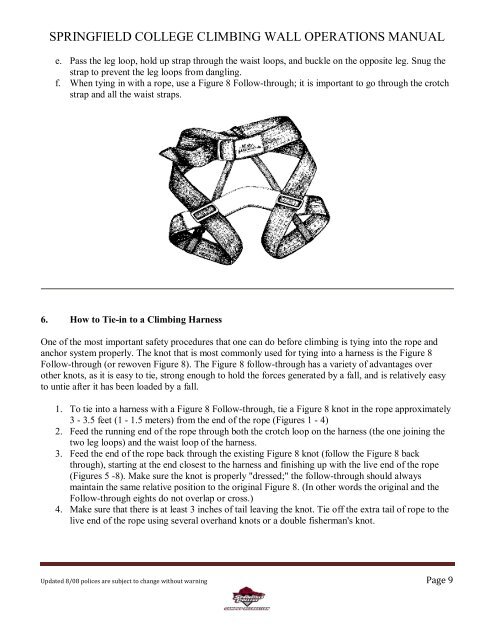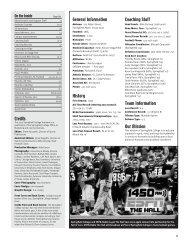CLIMBING WALL OPERATIONS MANUAL
CLIMBING WALL OPERATIONS MANUAL
CLIMBING WALL OPERATIONS MANUAL
Create successful ePaper yourself
Turn your PDF publications into a flip-book with our unique Google optimized e-Paper software.
SPRINGFIELD COLLEGE <strong>CLIMBING</strong> <strong>WALL</strong> <strong>OPERATIONS</strong> <strong>MANUAL</strong><br />
e. Pass the leg loop, hold up strap through the waist loops, and buckle on the opposite leg. Snug the<br />
strap to prevent the leg loops from dangling.<br />
f. When tying in with a rope, use a Figure 8 Followthrough; it is important to go through the crotch<br />
strap and all the waist straps.<br />
6. How to Tiein to a Climbing Harness<br />
One of the most important safety procedures that one can do before climbing is tying into the rope and<br />
anchor system properly. The knot that is most commonly used for tying into a harness is the Figure 8<br />
Followthrough (or rewoven Figure 8). The Figure 8 followthrough has a variety of advantages over<br />
other knots, as it is easy to tie, strong enough to hold the forces generated by a fall, and is relatively easy<br />
to untie after it has been loaded by a fall.<br />
1. To tie into a harness with a Figure 8 Followthrough, tie a Figure 8 knot in the rope approximately<br />
3 3.5 feet (1 1.5 meters) from the end of the rope (Figures 1 4)<br />
2. Feed the running end of the rope through both the crotch loop on the harness (the one joining the<br />
two leg loops) and the waist loop of the harness.<br />
3. Feed the end of the rope back through the existing Figure 8 knot (follow the Figure 8 back<br />
through), starting at the end closest to the harness and finishing up with the live end of the rope<br />
(Figures 5 8). Make sure the knot is properly "dressed;" the followthrough should always<br />
maintain the same relative position to the original Figure 8. (In other words the original and the<br />
Followthrough eights do not overlap or cross.)<br />
4. Make sure that there is at least 3 inches of tail leaving the knot. Tie off the extra tail of rope to the<br />
live end of the rope using several overhand knots or a double fisherman's knot.<br />
Updated 8/08 polices are subject to change without warning Page 9





